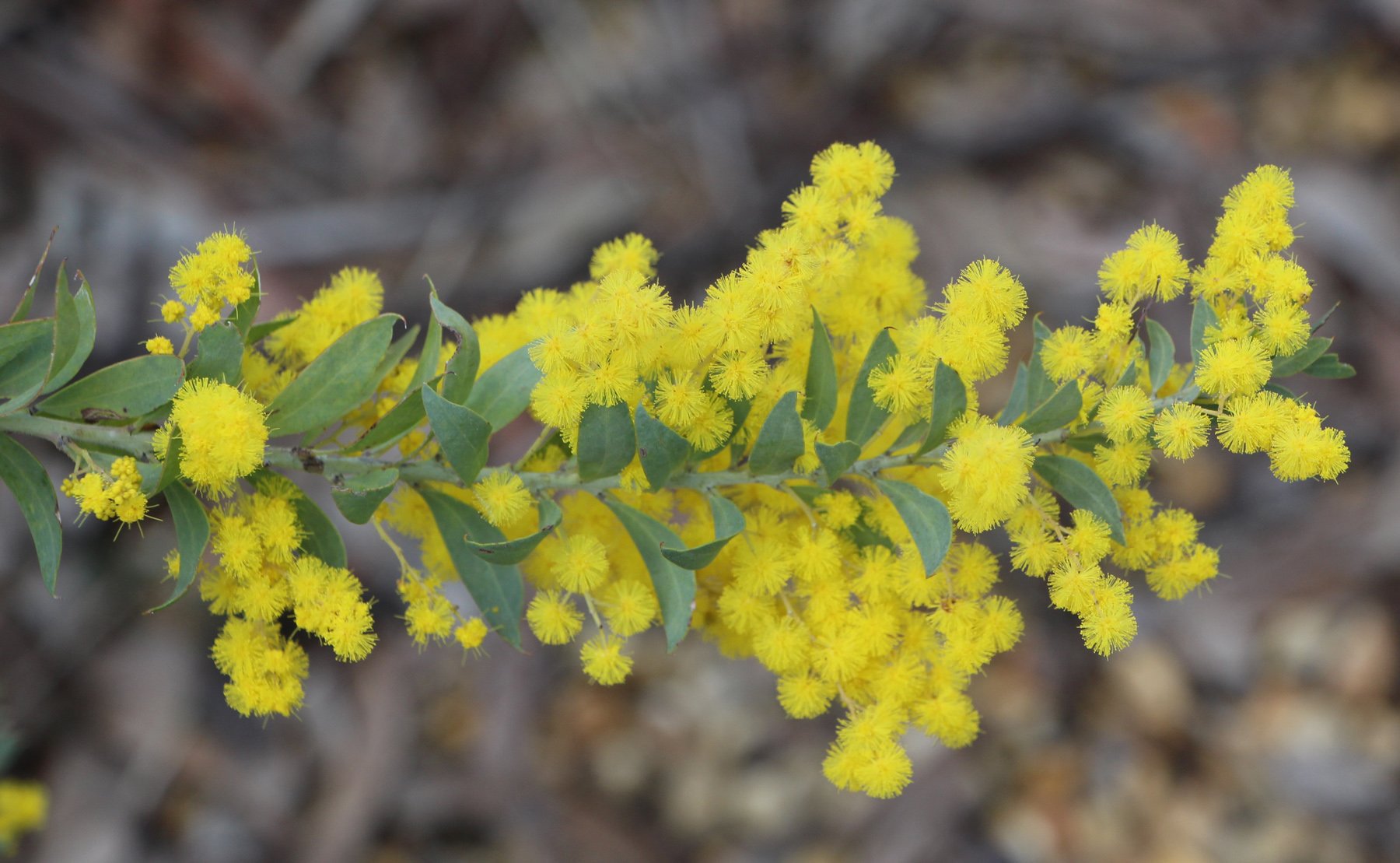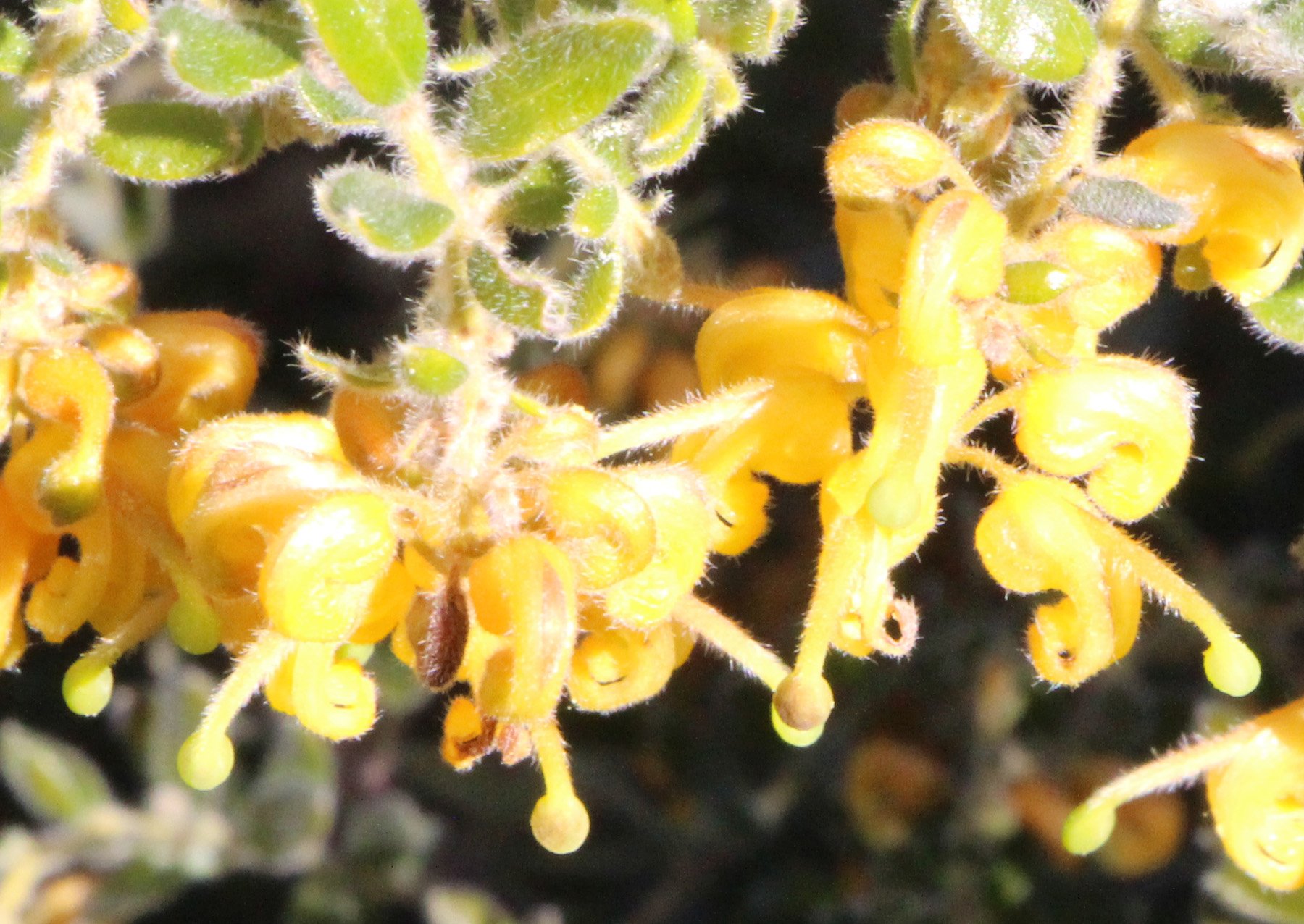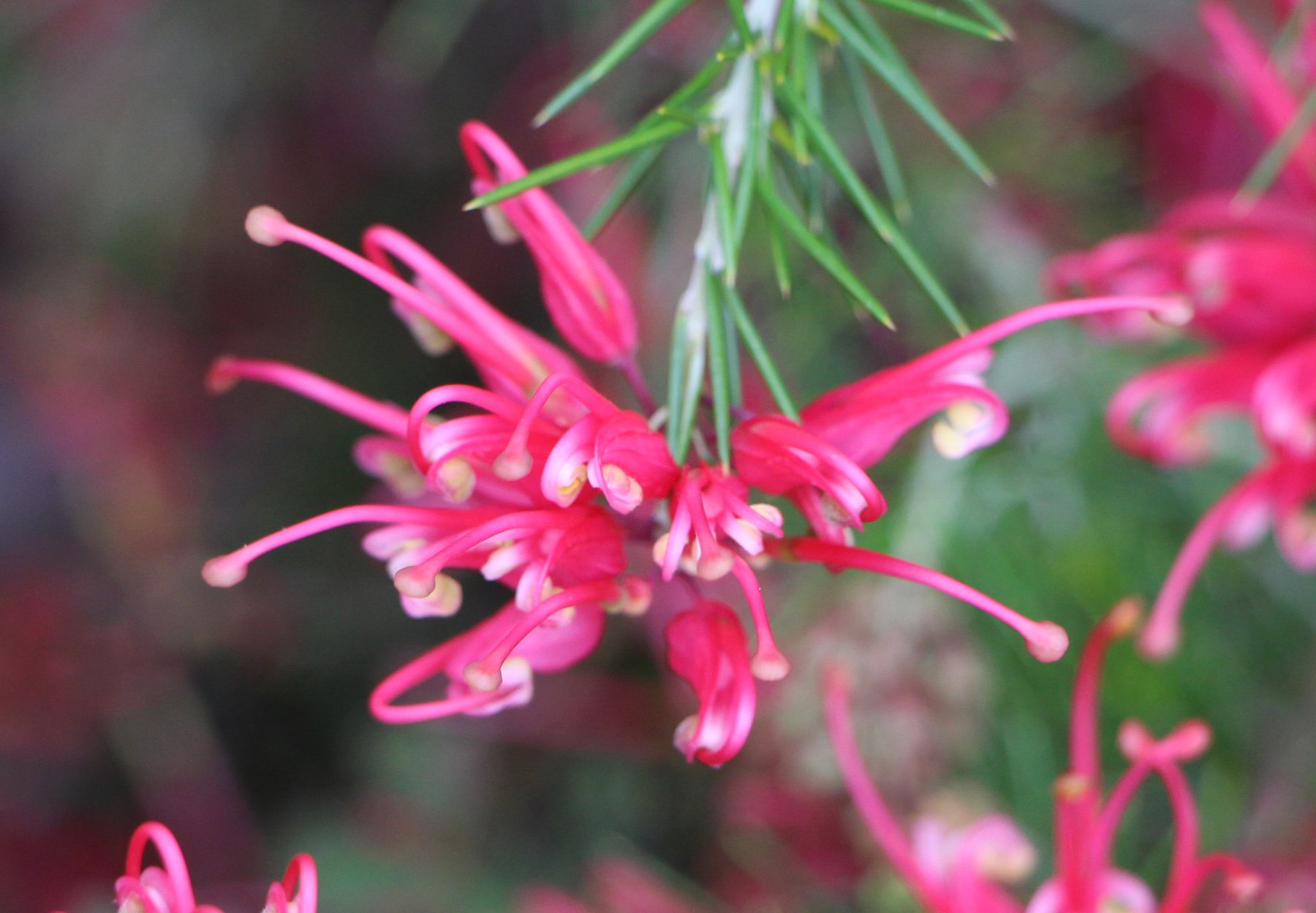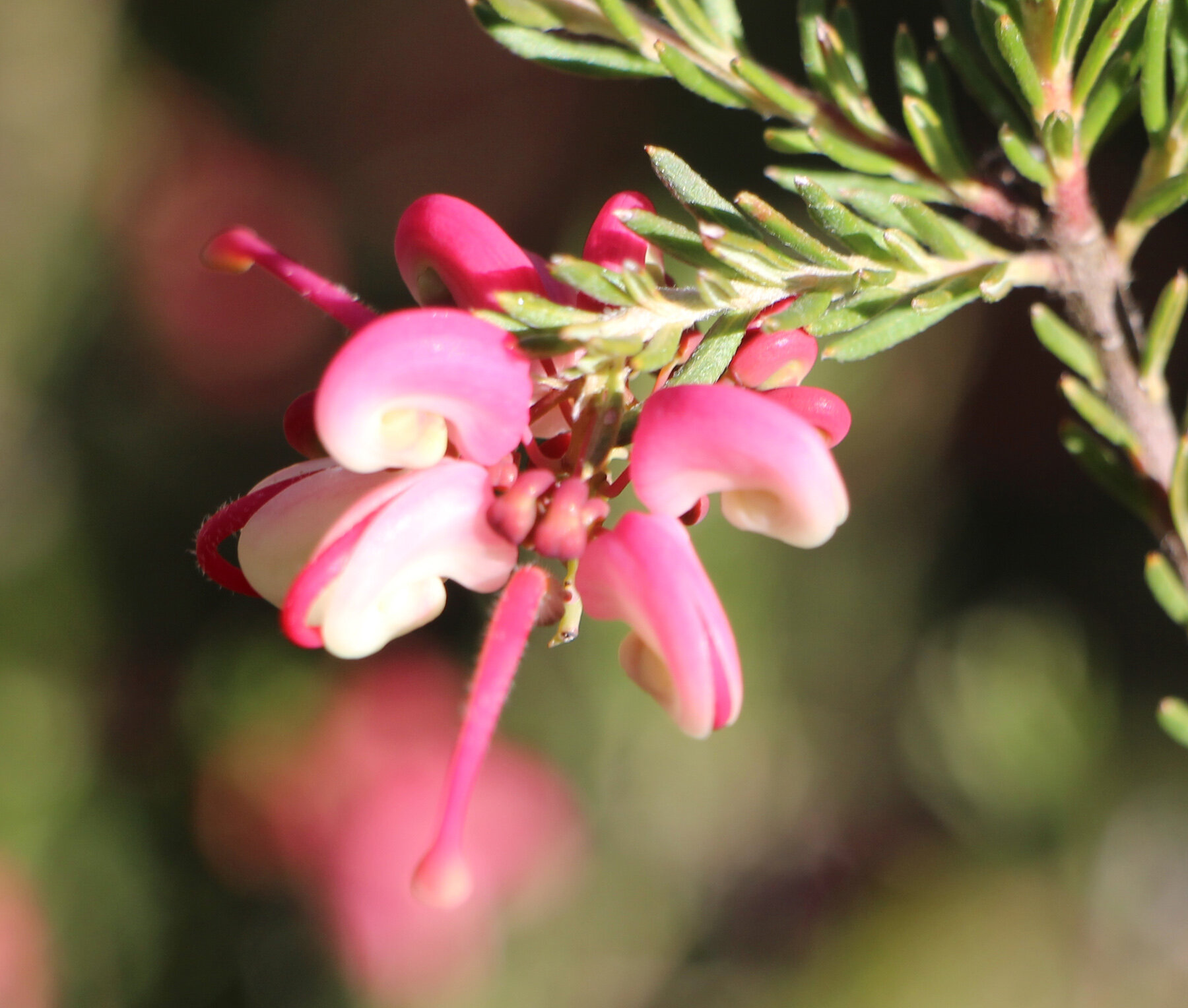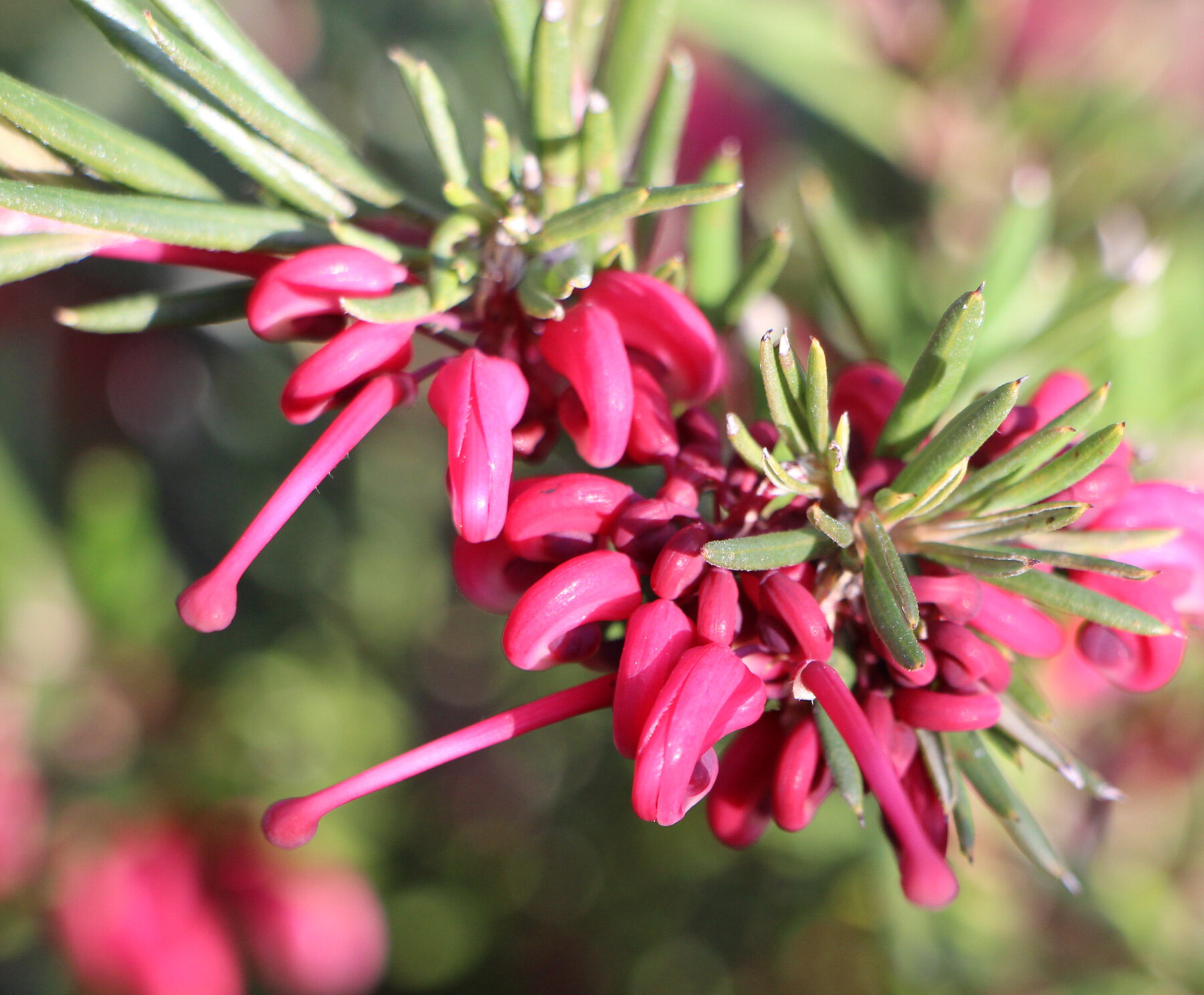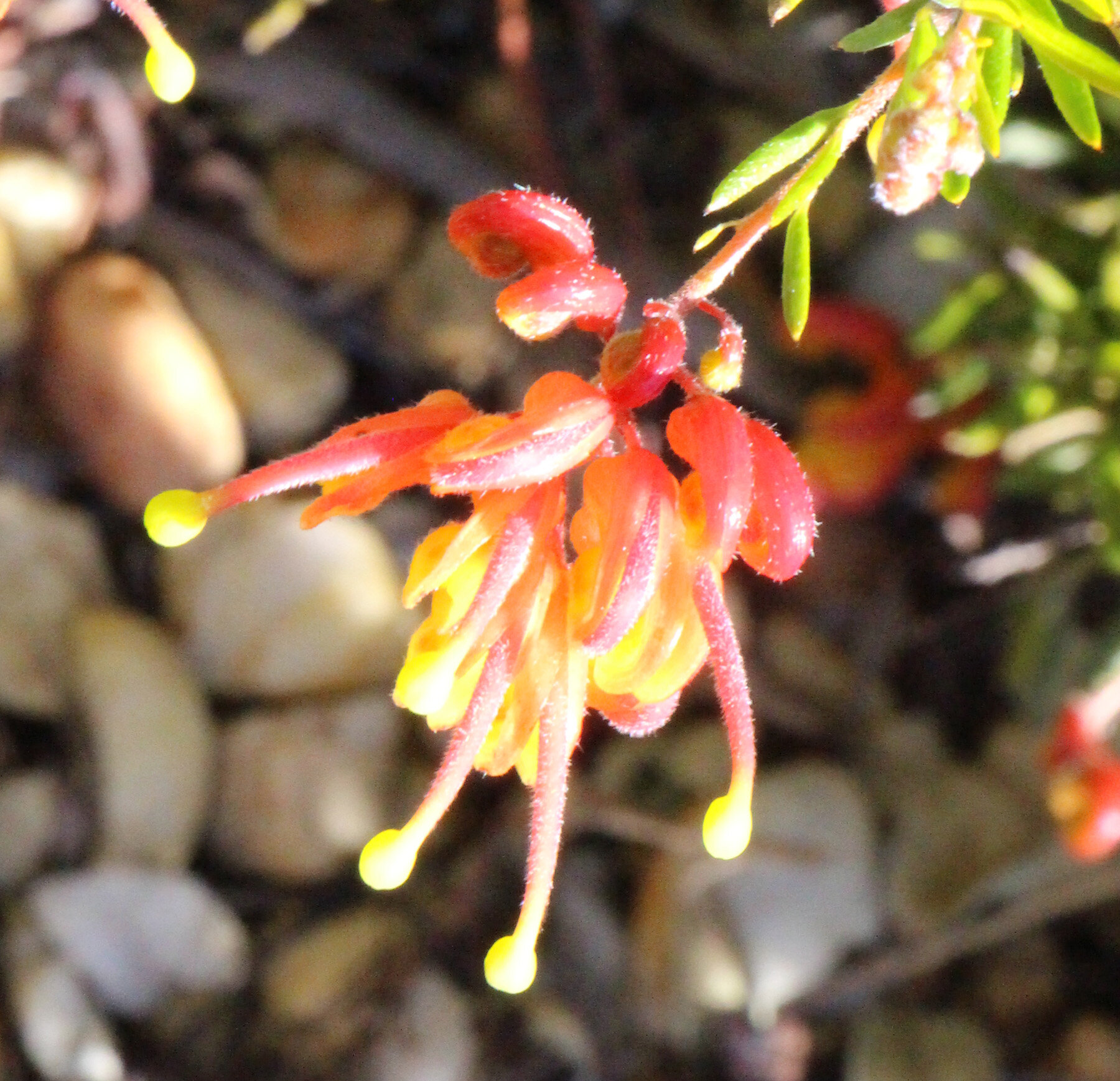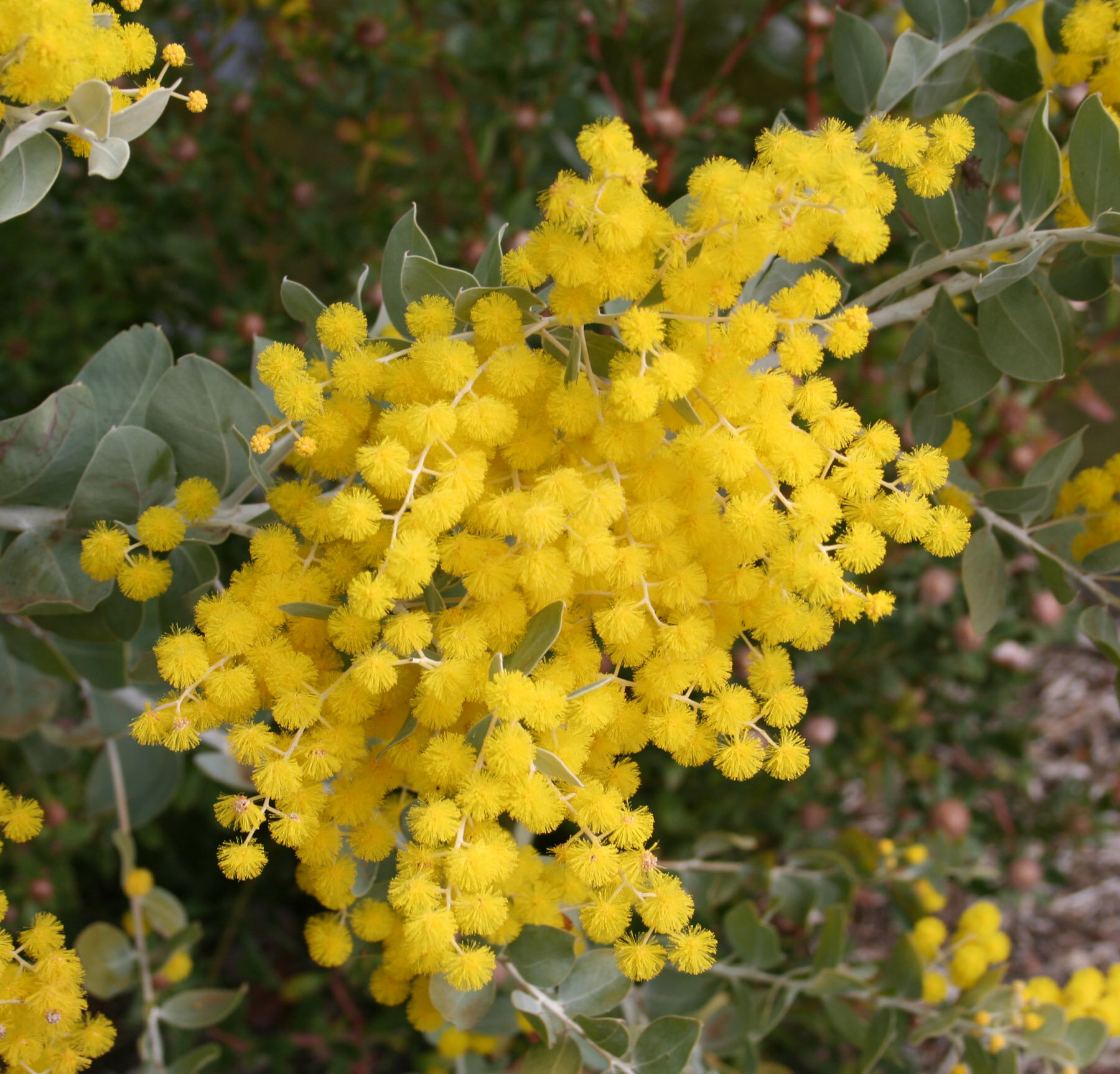August
Some plants that are in bloom in August
Click on any image to enlarge and scroll though all the images for each week.
Acacia cremiflora
25 Aug 2024
Starting from the top left:
Acacia baileyana purpurea – Purple Cootamundra Wattle
We planted this wattle, 5-8m high and wide, with fern like foliage with a distinctive bright purple tint and gold ball blossoms, in August 2014. This plant grows best in full sun and develops decorative purple seed pods.
Acacia ‘Bilby Blue’
We planted one of these shrubs, 3m x 3m, with grey green foliage and bright yellow ball flowers in April 2017.
Acacia leprosa ‘Just Peachy’
We planted this hardy shrub, 3-4m high x 2-3m wide, with peach-coloured flowers in spring in May 2023. This plant is best planted in full sun but will tolerate light shade.
Grevillea ‘Crimson Villea’
We have planted eight of these compact grevilleas with masses of showy crimson winter flowers, 80cm x 80cm, the first in February 2020, then others in 2021-23. This cultivar of G. rosmarinifolia had its first flowers for us in September 2020, forms a dense bush and flowers over a long period.
Grevillea lanigera lutea
We have planted four Grevillea lanigera lutea, or Woolly Grevillea, which form small shrubs in the garden, about 1m high, of which one remains. The best feature of this plant is its long flowering period. The yellow drooping racemes of flower are very cheerful and contrast nicely with the pale green foliage. This plant is a reliable performer in the garden and is native to southeastern New South Wales and the ACT.
Hovea lanceolata
We planted nine of these shrubs from the pea family, 2m high x 1m wide, with narrow greyish leaves and purple pea flowers in December 2018, and another three in September 2020 to replace the ones that died. This plant is found on rocky areas, sandy soils and ridges, growing west of the Great Dividing Range in northern New South Wales and Queensland. This plant prefers excellent drainage, cool root run and some overhead shade. We had excellent bloom over a long period in spring 2021 and 2022.
14 Aug 2024
Starting from the top left:
Acacia ‘Bilby Blue’
We planted one of these shrubs, 3m x 3m, with grey green foliage and bright yellow ball flowers in April 2017.
Acacia hakeoides
We planted this rounded shrub to 2.5m high x 2.5m wide, with grey-brown bark and long oblong phyllodes, in October 2017. Acacia hakeoides has bright yellow ball flowers and dark brown pods. Native to inland areas of NSW, Queensland, WA, Victoria, SA.
Eremophila oldfieldii ssp. angustifolia x E. oppositifolia ‘Piccaninny Dawn’
We have planted three of these compact shrubs, 3m high x 3m wide, with dark grey leaves and rose pink flowers, in 2011, 2018 and 2020. This plant will grow in a variety of soils, is drought tolerant and is somewhat tolerant of frost. Our first plant died after -6 deg. C. frost in June 2012. We have placed the other two under more overhead protection and they are flowering well.
Eremophila youngii
We have planted two of these upright shrubs, 1-2m high x 0.6-1m wide, with attractive grey foliage and tubular pink flowers, in 2010 and 2012. This plant is native to central WA. One died in April 2021, but the other is now over 2m high and blooms often.
Grevillea ‘Lady O’
Grevillea ‘Lady O’ is Ben’s favourite plant in our garden because it always looks healthy and never stops flowering. This plant is a hybrid between a Grevillea victoriae hybrid and Grevillea rhyolitica and has light green foliage and prolific red flowers. ‘Lady O’ was bred at Bywong Nursery and named after Peter Ollerenshaw’s mother. The bushy plant grows to 2m high and wide. We planted our first ‘Lady O’ in April 2004 and have planted 13 since then over the five years to 2009. This plant is a fabulous performer in our garden.
Hakea laurina x petiolaris ‘Pin Ball’ – Pincushion Hakea (grafted)
‘Pin Ball’ is a standout shrub in our garden, with leathery green to bluish green leaves with prominent veining and ball like red flowers with cream styles. We have planted four of these shrubs, 3.5 – 5m high x 3-10m wide.
5 August 2024
Starting from the top left:
Acacia baileyana purpurea – Purple Cootamundra Wattle
We planted this wattle, 5-8m high and wide, with fern like foliage with a distinctive bright purple tint and gold ball blossoms, in August 2014. This plant grows best in full sun and develops decorative purple seed pods.
Banksia ‘Bulli Baby’
We planted this dwarf banksia, which originated in the Bulli area and grows to only 1-2m high, in August 2012. This form has fine linear bright green leaves and spectacular orange/red spikes during autumn and winter. These flower spikes can be up to 20cm long and abundant. This plant prefers a sunny to partly shaded position in well drained soil.
Grevillea ‘John Evans’
We have planted six Grevillea ‘John Evans’ , but are left with just one volunteer remaining in our garden. We planted three in August 2004, then another three in November 2006. These thrived for several years, but eventually succumbed to drought and frost. The volunteer, which has placed itself in an open and frosty position, appeared in 2015. This plant is now 1m x 1m, with very dark green foliage and plenty of red flowers. We planted another in April 2022.
Grevillea x semperflorens
Grevillea x semperflorens’ was sold to us as ‘Mallee Dawn’ but Peter Olde quickly identified it for us as x semperflorens’, one of the earliest hybrid grevilleas ever produced. This cultivar was developed in England and was first formally described in 1937 by F.E. Briggs in The Journal of the Royal Horticultural Society of London as Grevillea semperflorens. We planted three in September 2007 and quickly realised our mistake as they grew much too large for their position and had to be removed. We planted another in February 2019 in a better spot, but this one disappeared for a few months, but has now reappeared and is flowering. The flowers are a lovely soft apricot colour. We have planted five more of these plants in October 2022.
Hakea bucculenta – Red Pokers
In November 2008 we planted Hakea bucculenta, a large shrub 4m high x 3m wide. which initially grew well but never flowered and was eventually removed. We planted a grafted plant in September 2009 which bloomed well with spikes of pinkish red flowers in August 2013 and has subsequently bloomed well each year and grown to 4m high. Phil Trickett thinks that our plant is a cross between H. bucculenta and H. francisciana. This plant species occurs in the wild on the central WA coast.
Hakea clavata
We have planted two of these shrubs, 1.5m high x 2.5m wide, with succulent like leaves and pale pink to white flowers, in March 2012 and November 2019. The foliage is unusual and a feature of the plant. Our first specimen, planted in March 2012, was hit by the frost in October of the same year and died. The second one we planted in pot in November 2019 and it is growing well so far and flowered for the first time in October 2021. This plant is native to the Esperance area of WA and is adapted to harsh conditions.
28 August 2023
Starting from the top left:
Acacia ‘Bilby Blue’
We planted one of these shrubs, 3m x 3m, with grey green foliage and bright yellow ball flowers in April 2017.
Acacia cardiophylla - West Wyalong Wattle
West Wyalong Wattle, 3-4m high, began as the most reliable of our wattles, with attractive feathery foliage and masses of bright yellow ball flowers in the spring. We planted 12 of these fast growing, tough plants in many different positions in the garden in 2003 and 2006, but they are a little frost sensitive in Canberra. We now have one remaining plant which was planted in February 2020. This plant is native to central and southern NSW.
Acacia ‘Twilight Glow’
We planted this hybrid A. howittii x leprosa seedling, 4-5m high x 2-3m wide, with rich green foliage and mustard pink ball flowers with yellow stamens, in August 2019. This plant was eaten to the ground by kangaroos December 2019 and looked poorly. We removed the original plant for failure to thrive in February 2022. We purchased another specimen to plant along the right hand boundary in July 2021 and are rewarded with our first flowers in September 2022.
Grevillea ‘Poorinda Queen’
We planted Grevillea ‘Poorinda Queen’ in October 2007 and it has developed into a large dense shrub with apricot flowers for a long period.
Paraserianthes lophantha – Cape Leeuwin Wattle or Plume Albizia
We planted this fast growing tree to 10m high, with fine bipinnate foliage and iridescent yellow-green toothbrush flowers, in January 2021. This plant is native to southwestern WA, from Fremantle to King George Sound. While it is strictly neither a wattle nor an albizia despite its common names, this tree has grown to 3m high and is flowering for the first time in April 2022. I have placed this plant in a very protected area with lots of sun, it has made it through one Canberra winter and I have high hopes that it will continue to cope. We have seed pods in October 2022. We have since planted another two of these trees on our back fence in 2024.
Phebalium nottii pink
We planted this mall bushy shrub to 1m high with dark foliage and clusters of pink star flowers in April 2021. This plant is frost and drought tolerant and is native to northern NSW and southern Queensland. The first blooms were in June 2021.
14 August 2023
Starting from the top left:
Correa ‘Windsong’
We planted two of these Correa reflexa hybrids, 30cm high x 2m wide, a mounding groundcover with greyish foliage and pastel pink and white flowers, in July 2021. Unfortunately one plant drowned in the rain in October 2022 - replaced.
Epacris reclinata
We planted this shrub, 0.6-1m high x 0.5m wide, with small prickly leaves and pink to red bell flowers in August 2019. This plant is native to the Blue Mountains, NSW. Magnificent all over flowering in May 2022, 2023 and 2024.
Grevillea ‘Hot Lava’
We planted this spreading shrub, 0.7m high x 1.2m wide, with many deep red flowers, contrasting with blue-green foliage, in March 2021.
Paraserianthes lophantha – Cape Leeuwin Wattle or Plume Albizzia
We planted this fast growing tree to 10m high, with fine bipinnate foliage and iridescent yellow-green toothbrush flowers, in January 2021. This plant is native to southwestern WA, from Fremantle to King George Sound. While it is strictly neither a wattle nor an albizzia despite its common names, this tree has grown to 3m high and is flowering for the first time in April 2022. I have placed this plant in a very protected area with lots of sun, it has made it through one Canberra winter and I have high hopes that it will continue to cope. We have seed pods in October 2022 and many flowers in winter 2023.
Phebalium nottii pink
We planted this mall, bushy shrub to 1m high, with dark foliage and clusters of pink star flowers, in April 2021. This plant is frost and drought tolerant and is native to northern NSW and southern Queensland. The first blooms were in June 2021.
Pimelea physodes (grafted) – Qualup Bell
We have planted five of these shrubs, 1m x 1m, with grey-grey foliage and pendant bell-shaped bracts enclosing the small flowers, in pots from 2011-2022. One plant grafted onto Pimelea ferruginea rootstock lasted for ten years and attracted birds to its flowers every year. Our original plant was frosted off and two others were destroyed by Crimson Rosellas, but our newly planted one is flowering well. This plant is native to southwestern Western Australia and is considered the most outstanding of the genus.
29 August 2022
Starting from the top left:
Acacia leprosa ‘Scarlet Blaze’ – Cinnamon Wattle
we have planted six ‘Scarlet Blaze’, a small evergreen tree, height 4-5m, fast growing, with a semi weeping habit, from 2005-2014, but only one remains. Commonly known as Cinnamon Wattle because leaves crushed in warm weather release a cinnamon like fragrance. The red flowers are spectacular and showy. A single specimen with red flowers was found in vVctoria, but is now not known in the wild. We find in our garden that these plants must be protected from the wind, as they are quite brittle.
Acacia paradoxa – Kangaroo Thorn
We planted this spreading, prickly shrub, 2-3m high x 3-4m wide, with small elliptical phyllodes, stems with stiff spines and yellow ball flowers, in November 2012. This plant is native to southeastern Australia, from Queensland to South Australia. This plant turned brown and died to nothing in 2017, but has come back and flowered well. We have also removed a seedling from this plant and sited it elsewhere. in the garden.
Banksia praemorsa – Cut Leaf or Urchin Banksia
We have planted seven of these shrubs, 3m high x 2m wide, with stiff upright stems, deep green foliage and bright yellow or red flowers which are attractive to honeyeaters, from 2007-16. These plants, native to the south coast of WA, near Albany, are very showy in flower. Most of our plants have died, but one in the garden and one in a pot, survive. The flowers are often frosted off in our climate.
Eremophila arbuscula
Name means small tree. We planted this tree, to 11m high, with narrow silver-grey drooping leaves and sweetly scented, creamy yellow flowers with yellow or orange spots, in March 2014. This tree is native to southern Queensland where it grows on stony or loamy soils in full sun.. A magnificent plant with gnarled appearance even at an early age.
Grevillea ‘Poorinda Adorning’
We planted this spreading shrub, 0.5 – 1m high x 2m wide, with narrow prickly leaves and terminal pinkish-red woolly spider flowers, in October 2015.
Hakea gibbosa - Hairy Hakea
We obtained seeds of Hakea gibbosa, or Hairy Hakea, from a friend in March 2015, germinated them and planted three of them into the garden in December 2015. These have been incredibly slow growing for us, still only about half a metre high after seven years. They are supposed to make a conifer like shrub to 3m tall with viciously prickly grey leaves and cream axillary flowers. This plant occurs in the Sydney region of NSW. This plant finally flowered for the first time for us in August 2022.
22 August 2022
Starting from the top left:
Acacia ‘Bilby Blue’
We planted one of these shrubs, 3m x 3m, with grey green foliage and bright yellow ball flowers in April 2017.
Acacia floribunda – Gossamer Wattle
We planted two of these small trees, with bright green feathery lance shaped leaves and bright yellow strongly scented flower spikes, in March 2004. This is a fast-growing, showy wattle in cool moist conditions in part shade. This plant is native to NSW, Queensland and Victoria.
Acacia longifolia – Sallow Wattle
We planted this fast growing shrub , height 3-10m x width 2-8m, with leathery leaves and scented rod flowers, in May 2010. This tree adds winter colour and attracts nectar feeding birds. Native to coastal area of southeastern Queensland, NSW, Victoria and South Australia.
Clematis microphylla
We planted Clematis microphylla or Small Leafed Clematis, in March 2007 on a frame near a fence. This plant has now climbed ambitiously into a nearby tree and flowers generously every year with small greenish cream flowers. The foliage is dullish green with three leaves together and the flowers of female plants produce one-seeded dry fruits that have a feathery tail. The fruits are very light and the feathery tail allows them to be dispersed by the wind. This plant is native to all states of Australia, except NT.
Grevillea ‘Crimson Villea’
We planted this compact grevillea with masses of showy crimson winter flowers, 80cm x 80cm, in February 2020. This cultivar of G. rosmarinifolia had its first flowers in September 2020.
Hakea francisciana ‘Pomonal Pink’
Hakea francisciana ‘Pomonal Pink’ is a grafted, tall woody shrub with narrow grey leaves and spectacular long pink brush flowers in winter and spring. This plant can eventually grow to 5m high and wide, but so far the one we planted in our garden, in September 2013, is 3m high and 2m wide, with an attractive oval shape. This plant first flowered for us in October 2014 and has continued to flower each year with more and more flowers. As this plant was such a success we bought another grafted specimen in November 2017, but this plant has turned to have green leaves, and so far, no flowers. It remains to be seen whether this plant will bloom with the same showy flowers.
15 August 2022
Starting from the top left:
Acacia baileyana purpurea – Purple Cootamundra Wattle
We planted this wattle, 5-8m high and wide, with fern like foliage with a distinctive bright purple tint and gold ball blossoms, in August 2014. This plant grows best in full sun and develops decorative purple seed pods.
Acacia covenyi – Blue Bush or Bluebush
We have planted nine of these vigorous small trees, height 5-6 m, with bluish-grey foliage and bright yellow ball lowers, from 2004-2015. This species is from Deua National Park (NSW) and is listed as rare. Several of these plants have been blown over in windstorms, but four survive.
Correa ‘Ring A Ding Ding’
We planted eight of these compact shrubs, height 50cm x width 60cm, with glossy green foliage and many bright orange bell flowers, in August 2016.
Hakea coriacea - Pink Spike Hakea
We have planted four Hakea coriacea, or Pink Spike Hakea, the first three in the garden, all of which met a sticky end. Two of them were blown over in the wind. They were rotted out at the base as our garden is a bit too wet for them. This shrub, 2-4m high and 2-3m wide, with grey-green leathery leaves and pink spikes of flower, comes from the Kalgoorlie area of WA. We planted one in a pot in November 2013 then moved it into the garden in December 2016. This plant is now 3m high and has bloomed sparingly. I could wish for more blooms. Many more blooms arrived in spring 2021 with the extra La Nina rain.
Hakea francisciana ‘Pomonal Pink’
Hakea francisciana ‘Pomonal Pink’ is a grafted, tall woody shrub with narrow grey leaves and spectacular long pink brush flowers in winter and spring. This plant can eventually grow to 5m high and wide, but so far the one we planted in our garden, in September 2013, is 3m high and 2m wide, with an attractive oval shape. This plant first flowered for us in October 2014 and has continued to flower each year with more and more flowers. As this plant was such a success we bought another grafted specimen in November 2017, but this plant has turned to have green leaves, and so far, no flowers. It remains to be seen whether this plant will bloom with the same showy flowers.
Phebalium nottii pink
We planted this mall bushy shrub to 1m high with dark foliage and clusters of pink star flowers in April 2021. This plant is frost and drought tolerant and is native to northern NSW and southern Queensland. The first blooms were in June 2021.
8 August 2022
Starting from the top left, winter flowering Grevilleas:
Grevillea alpina ‘Goldfields’
We planted two Grevillea alpina ‘Goldfields’ in September 2011. These are small, mounding plants with hairy, greyish leaves and pale gold flowers in spring. They both flowered in 2012, but one died in 2015 and the other was crowded out and was removed in October 2017. Six months before removal Ben took cuttings and we planted three of them in 2017. Two have died, but the third is thriving.
Grevillea ‘Carol Ann’
We have planted three Grevillea ‘Carol Ann’, a hardy plant, 2 m wide, with dense dark green foliage and red spider flowers, the first in 2013, then two more in 2016. We have grown one drooping most effectively over a wall. These plants bloom generously for a very long period. This plant is a favourite for bees and a non-stop performer for us.
Grevillea ‘Crimson Villea’
We planted this compact grevillea with masses of showy crimson winter flowers, 80cm x 80cm, in February 2020. This cultivar of G. rosmarinifolia had its first flowers in September 2020.
Grevillea lanigera ‘Celia’
We planted three of these low hardy shrubs, 45cm high x 1m wide, with pink and white flowers, in 2018.. This plant needs full sun and is frost hardy, and the flowers attract birds
Grevillea ‘Sid Reynolds’
Grevillea ‘Sid Reynolds’, planted in September 2014, has already grown to a dense rounded shrub 2.5m high and wide with lovely spider flowers of red and pink with a yellow limb. We saw a shrub of ‘Sid’ in South Australia at Pangarinda Botanic Gardens which was much larger, probably 4m x 4m, in full flower, a magnificent sight.
Grevillea ‘Woolly Bear Hero’
Grevillea ‘Woolly Bear Hero’ is a selection of G. lanigera, a low plant about 1m wide, with attractive grey-green foliage and dark pink flowers over a long period. We have planted five of them over a five year period, 2010-15, in various parts of the garden and they perform well.
2 August 2021
Starting from the top left:
Acacia longifolia
We planted this fast growing shrub , height 3-10m x width 2-8m, with leathery leaves and scented rod flowers, in May 2010. This tree adds winter colour and attracts nectar feeding birds.
Acacia siculiformis
We planted this stiff shrub, 1-2m high x 1-2m wide, with narrow pointed foliage and globular yellow flowers, in March 2014. This prickly plant is a useful refuge for small birds.
Banksia spinulosa ‘Honey Pots’
We have planted ten of these shrubs, 0.5m high x 0.5m wide, with nectar rich flowers from late summer through to spring. Our original shrub, planted in April 2006, has grown to 1.5m high and wide, much larger than advertised on the label.
Correa 'Pink VoVo'
We planted this Correa backhouseana x reflexa hybrid, 1.2 m high x 1.5 m wide, an open shrub with pink and cream bell flowers, in October 2013.
Eremophila oppositifolia ‘Hardy Harry’
We planted this shrub, 2.5m high x 1.5m wide, with lovely grey foliage and pinkish-white flowers over a long period, in October 2010.
Grevillea ‘Winter Kiss’
We planted this low ground-covering plant, 0.15m high x 1m wide, with small bright green leaves and plenty of red and cream spider flowers, in February 2015. This grevillea is a popular bird plant and very hardy.
9 August 2021
Stgarting from the top left:
Acacia bailyana purpurea
We planted this hardy wattle, 5-8m high and wide, with fern like foliage with a bright purple tint, and winter flowering gold ball blossoms, in August 2014. The purple seed pods are a welcome feature and remain on the tree over a long period after flowering.
Isopogon cuneatus
We have planted five of these upright shrubs, 2m high x 1m wide, with flattish bright green leaves and large pink drumstick flowers, in 2016-17. Only the one grafted plant remains in 2021. This plant is native to southern WA, between Albany and Esperance.
Grevillea ‘Emma Charlotte’
We planted this hybrid grevillea, 0.5m high x 1m wide, a cross between G. rosmarinifolia and G. lanigera, in June 2008 The flowers are deep pink and attractive to birds.
Grevillea ‘John Evans’
We have planted six Grevillea ‘John Evans’ (photo above), but are left with just one volunteer remaining in our garden. We planted three in August 2004, then another three in November 2006. These thrived for several years, but eventually succumbed to drought and frost. The volunteer, which has placed itself in an open and frosty position, appeared in 2015. This plant is now 1m x 1m, with very dark green foliage and plenty of red flowers.
Grevillea ‘Poorinda Tranquiity’
We planted one Grevillea ‘Poorinda Tranquility’ along the fence line in August 2019, then two more on the hill in December 2019. We hope that these will grow to large shrubs with grey-green foliage and profuse pink and cream flowers. The smaller ‘Poorinda’ shrubs that we grow are ‘Adorning’, ‘Marian’, ‘Rondeau’ and ‘Royal Mantle’. ‘Adorning’, planted in October 2015, is a small spreading shrub 0.5 – 1m high and 2m wide, with narrow prickly leaves and terminal bright pinkish-red spider flowers.
Westringia glabra
We planted one of these shrubs, height 1-2.5m x 1-2.5m wide, with many soft mauve flowers, in December 2019. This adaptable plant can be pruned easily and will accept many different conditions.
16 August 2021
Starting from the top left:
Acacia covenyi – Blue Bush or Bluebush
We have planted nine of these vigorous small trees, height 5-6 m, with bluish-grey foliage and bright yellow ball lowers, from 2004-2015. This species is from Deua National Park (NSW) and is listed as rare. Several of these plants have been blown over in windstorms, but four survive.
Banksia spinulosa ‘Coastal Cushion’
We planted three of these small shrubs, 50cm high and 1.5m across, with lush green foliage and yellow cone flowers with maroon styles in October 2014. One did not thrive and was replaced in January 2021, but the others are flowering well.
Eremophila maculata orange form
We planted this spreading shrub, 2m high and wide, with orange flowers in September 2017.
Grevillea ‘Crackles’
We p[lanted this small shrub, 1m x 1m, with a prolific display of red and yellow flowers in October 2019. This plant is a bee and bird attractor, needs full sun and is frost tolerant.
Grevillea ‘Hills Jubilee’
Grevillea ‘Hills Jubilee’ (photo above right) was selected by The Hills Grammar School for their 25th jubilee year. This Bywong Nursery introduction was planted in September 2008 and forms an attractive small shrub that flowers profusely with pink and white flowers. It has grown to approximately 1.5m high and 1m across.
Grevillea ‘Orange Box’
Grevillea ‘Orange Box’ is a very reliable compact bush, 1.5m high and 1.2m wide, with glossy dark green foliage and many bright orange flowers during the year. This is a plant which can be trimmed into a hedge or allowed to grow naturally. We have planted two of them, one in September 2006, which was blown over in a storm, and another in September 2015 which persists.
23 Ausgust 2021
Starting at the top left:
Acacia longifolia – Sallow Wattle
We planted this fast growing shrub , height 3-10m x width 2-8m, with leathery leaves and scented rod flowers, in May 2010. This tree adds winter colour and attracts nectar feeding birds.
Acacia podalyriifolia
We planted this silvery grey tree, 6m high x 5m wide with rounded foliage, massed golden flowers and large grey pods, in February 2020.
Grevillea ‘Orange Box’
Grevillea ‘Orange Box’ is a very reliable compact bush, 1.5m high and 1.2m wide, with glossy dark green foliage and many bright orange flowers during the year. This is a plant which can be trimmed into a hedge or allowed to grow naturally. We have planted two of them, one in September 2006, which was blown over in a storm, and another in September 2015 which persists.
Grevillea ‘Poorinda Queen’
We planted Grevillea ‘Poorinda Queen’ in October 2007 and it has developed into a large dense shrub with apricot flowers for a long period.
Hakea francisciana ‘Pomonal Pink’
Hakea francisciana ‘Pomonal Pink’ is a grafted, tall woody shrub with narrow grey leaves and spectacular long pink brush flowers in winter and spring. This plant can eventually grow to 5m high and wide, but so far the one we planted in our garden, in September 2013, is 3m high and 2m wide, with an attractive oval shape. This plant first flowered for us in October 2014 and has continued to flower each year with more and more flowers. As this plant was such a success we bought another grafted specimen in November 2017, but this plant has turned to have green leaves, and so far, no flowers. It remains to be seen whether this plant will bloom with the same showy flowers.
Hakea multilineata - Grass-leaf Hakea
Hakea multilineata, or Grass-leaf Hakea, is an outstanding shrub to 3-4m high and 2m wide with narrow stiff green leaves and long spikes of pink flowers. This plant occurs in southwestern WA. We planted one in March 2010, which flowered for the first time, sparsely, in September 2013. Just as it was budded up to flower more freely it blew over in a windstorm in March 2015. The problem was rotting out at the base. Our garden is a bit too wet for this species , so the next one we planted in October 2015 we incorporated plenty of sand in the hole. This plant has grown and flowered well over the last few years.






































